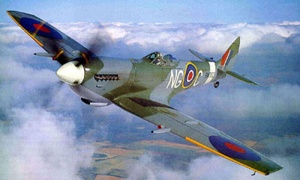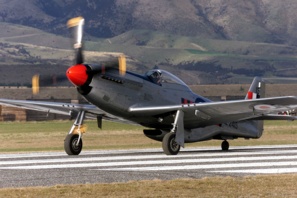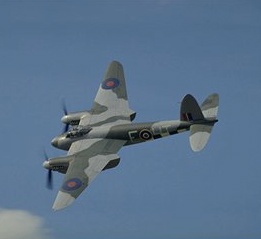Steven Den Beste has replied to my remarks about World War Two aircraft. Tally ho!
Perry’s British sensibilities do not need to be defensive about that, because the British contributed nearly as much to the success of the Mustang as did the Americans.
It has nothing to do with my ‘British sensibilities’ but I do know a thing or two about aerocraft of the era.
As a Brit, it was inevitable that Perry should be nostalgic about the Spitfire. In 1940 there was no better air defense fighter in existence, and the UK damned well needed it. Twice as many Hurricanes fought in the Battle of Britain than Spitfires, but it was the Spitfires which made the difference because the Hurricanes were not really able to stand up to the 109’s. That said, it has to be recognized that as an all-around fighter, the Spitfire had major weaknesses, especially compared to later designs. Its airframe wasn’t as rugged as those the Americans built, and for most of the war it was undergunned (because it relied on .30 caliber machine guns). And its biggest weakness all through the war was short legs; it simply could not carry enough fuel for anything except defense.
I will try not to get too irked that Steven seems to imply that my presumed nationality somehow skews my historical judgement. He also should have read my article more carefully. I said I was talking about mid-to-late war piston engined fighters (the P-51 was not around in the early war period), and what Steven is describing is a 1940 Battle of Britain era Spitfire I. By 1941 all (non-PR) Spitfires, from the Spit V onwards, were armed with two 20mm cannon as well as (usually) four .303 machine guns. It is the lack of cannon armament in the P-51 to which I was referring. More importantly all the Luftwaffe fighters which the USAAF were facing were cannon armed aerocraft. Of course it was not a decisive flaw because the six 50 cal HMGs favoured by the USAAF were good enough.
When most aficionados of WWII aircraft speak of “the best”, it mainly becomes a question of sending 8 of each into the air to duke it out and see how many of each come back. On that basis, the Spitfire would not have rated against the Mustang because of the Spit’s final drawback: it wasn’t as fast. In combat, speed is life. Which doesn’t take anything away from the Spitfire’s designers; North American designed the Mustang six years later and had learned much.
Quite incorrect. Stephen seem to be again comparing the 1940 Spitfire I with the 1943+ Mustangs, rather than the Spits that were flying at the same time as the various marks of Mustang (such as the Spit IX or the formidable Spit XIV or Spit XIX). In fact, there was never really anything to choose between the two fighters in terms of speed because as the newer versions of Mustang came out, so did the newer versions of Spitfire. There were many versions of the P-51 and even more of the Spitfire and the Spits in particular had many sub-variants optimised for certain altitudes making the comparisions even harder. In fact the late war Griffon engined Spitfires were generally both faster, better armed and more heavily armoured than the directly contemporary Mustang versions. But this also goes to show the fallacy of comparing them at all: the Mustang was fighting most of its battles at very high altitude over Germany, for which it was optimised and handled beautifully, whilst the Spitfires were fighting at low to medium altitude over the battlefront or defensively over Britain, neither of which required long range. Certainly Spitfire LF variants would be able to outfly a Mustang of equal era at low altitude by a significant margin, but that is not really what Mustangs were for, even if they were occasionally used that way, so is it even a useful comparison?
Perry brings up night-fighters. They were important (especially to the RAF, which did most of its bombing at night) but most people don’t consider them to be the same kind of thing. Night fighters had to be larger because they had to carry radar. There was much less emphasis on maneuver because night fighters didn’t tangle with each other, so most of the emphasis was on simple ability to carry weight. The Mosquito made a decent night fighter, but it could never have competed during the day. (It is noteworthy that the ME-110 was meat on the table during the day but ended up being a pretty decent night fighter.)
The fact is RAF nightfighters did indeed operate against Luftwaffe nightfighters. For much of the war, hunting German nightfighters was the primary RAF nightfighter mission, both as escorts to the RAF night bomber streams and as night counter-air intruders over German airfields. If you want to know more about that I strongly recommend History of the German Night Fighter Force by Gebhard Aders. It is written from the German point of view and is a superb book, pretty much the definitive work on the subject of the night air war in WW2.
Also to compare a Mosquito (of any mark) with an Bf.110 is like comparing a Ferrari with a Pinto. Mosquitos did indeed operate against single engined day fighters in a way that would have been suicide for a Bf.110. There are a host of books on the history of the Mosquito, but I would recommend Mosquito by C. Martin Sharp & Michael J. F. Bowyer, if you want to see a very broad range of information and statistics of all versions. By day, what it could not outfight it could outrun (until the jets arrived of course). Mosquito day fighter-bombers (mostly the FBVI version) regularly clashed with high performance single seat fighters like the formidable Fw. 190 and were quite capable of holding their own. For some excellent accounts of Mosquito tactical day and night operations, I recommend 2 Group RAF: a compete history. 1936-1945 by Michael J. F. Bowyer, which I have just finished re-reading.
[…] If one really wants to open up all the stops and say what the best fighter of the war, anyplace, anytime was on the basis of “send 8 up and see how many come back” then there is no question of the choice: it would be the pure fighter version of the ME-262. With a hundred mph edge in speed and a decent weapons load, it was deadly. It is fortunate for us that Hitler had his head wedged and ordered the majority of ME-262’s to be equipped as fighter-bombers.
Maybe, maybe not. There are many historians who disagree with that widely held view and contend it was production problems, not the so called ‘bomber directive’ that was actually the reason so few Me-262’s ever became operational.



Update: As a couple people have asked me to recommend some sources regarding my remarks about the Mosquito, I have edited the article to include two in the text above.



